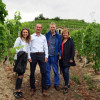
THE PERILS OF RECORD TEMPERATURES
JULY 2019
The highest temperature ever recorded in FRANCE was on Friday 28 June, 2019: 45.9°C in the afternoon at GALLARGUES-LE-MONTUEUX in the GARD département [30]. GALLARGUES stands just west of the COSTIÈRES-DE-NÎMES vineyards, which duly suffered from the consequences of this extreme episode.
ANNE COLLARD, of the excellent, organic CHÂTEAU MOURGUES DU GRÈS, told me: “the vines were stressed by that heat spike; for us, burning on the grape bunches was limited, but I know of vignerons across COSTIÈRES who lost 20-30% of their harvest. It’s very dry now, and there is a risk of fires. For the vineyards, the undersoil of clay below the galet stones has helped to lock in some humidity. We’d love an August storm!”
Up the road at TAVEL, RICHARD MABY, whose TAVEL and LIRAC rosés are winners each year, explained: “I have never before seen what is termed chaudages – the grapes burned in one day, the bunches grilled, turning a brown-black colour in just a few hours. That day, temperatures in the vineyards were over 50°C – the 45° was in the shade!”
The real problem occurred if growers had treated their vines with powdered or micronized sulphur shortly before the sudden jump in heat. With memories of the vast mildew attacks of 2018 still fresh, it is unsurprising that people were keen to treat with the sulphur to combat mildew [and to a lesser extent, oïdium]. The trouble was that the combination of extreme heat and leftovers of the sulphur applications combined to burn the bunches on the vines – the leaves were not affected.
“In my view, it would have been better to treat at the start of the night,” says RICHARD MABY, “and there were also those who were merely following their regular 10-day treatment cycle just before the 28 June – they were just unlucky.”
The intense heat was also experienced in the next département to the north of the GARD, the ARDÈCHE [07]. OLIVIER LERICHE of the organic-biodynamic DOMAINE DES ACCOLES – a great source for stylish VIN DE FRANCE wines that include a CARIGNAN GRIS white - told me: “if you treated two days before, your bunches were burned. I treated our vines on 20 June, and on 21 June a rainfall of 15 mm (0.6 in) washed away a large part of the sulphur, so we were OK. However, I know that people who treated on 3-4 July, after the record heat, also ran into trouble. We renounced all treatments across a three week period – even if you treat at night, you can have burning the next day.
I found that the SYRAH was more prone to the grilling than the confirmed southern varieties such as GRENACHE, CARIGNAN and CLAIRETTE. Younger vines were also more affected than the older ones.”
“This year, the handling of the vineyards is extremely important, even vital,” he continued. “The root structures are so important in these arid conditions. We’ve had 35 mm (1.2 in) of rain in June, 37 mm (1.5 in) in May, 64 mm (2.6 in) in April, and 20 mm (0.8 in) in March. If comparing to 2017, this year has had more June rain – in 2017, there were only 2-3 mm, for instance, and a total of just 30 mm (1.2 in) for the three months June to August in 2017.”
Savage heat, dry soils, the lottery of sulphur treatments – as I have written before, these are times when the parameters for viticulteurs are vastly broader than they were when I started out in the 1970s, when the growing seasons year after year roughly resembled one another – the one hundred day rule from flowering to harvesting was intact, you could harvest at any time of day, not just at dawn, and degrees ranged between 12° and 13.5°. There were many more certainties in those times.

